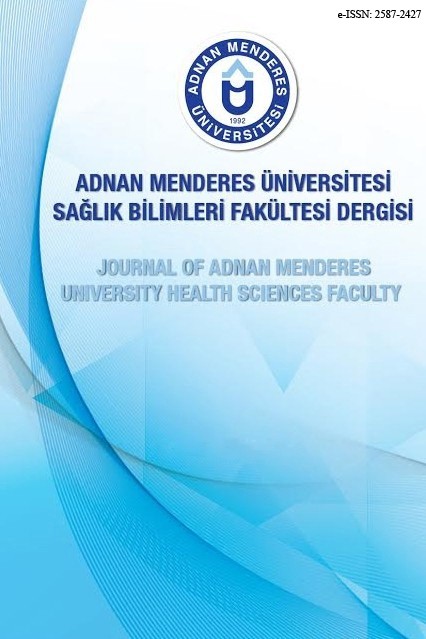Çocuklarda Akran Zorbalığı ve Benlik Saygısının İncelenmesi
Okul Sağlığı, Akran Zorbalığı, Benlik Saygısı, Okul Hemşireliği
Examination Of Peer Victimization And Self-Esteem In Children
School Health, Peer Bullying, Self-Esteem, School Nursing,
___
- 1. Smalley, K. B., Warren, J. C., Barefoot, N. (2017). Connection between experiences of bullying and risky baheviors in middle and high school students. School Mental Health; 9, 87.
- 2. Cooper, G., Clements, P., Holt, K. (2012). Examining childhood bullying and adolescent suicide: Implications for school nurses. The Journal of School Nursing. 28(4), 275- 83.
- 3. Farmer, T. W., Petrin, R. A., Robertson, D. L., Fraser, M. W., Hall, C. M., Day, S. H., et al. (2010). Peer relations of bullies, bully-victims, and victims: The two social worlds of bullying in second-grade classrooms. The Elementary School Journal. 110(3), 364-92.
- 4. Olweus, D. (1993). Bullying at school: What we know and what we can do. Cambridge MA: Blackwell. 8-13.
- 5. Hein, V., Koka, A., Hagger, S. A. (2015). Relationships between perceived teachers' controlling behaviour, psychological need thwarting, anger and bullying behaviour in high-school students. Journal of Adolescence. 42(2), 103-14.
- 6. Tillfors, M., Persson, S., Willén, M., Burk, W. J. (2012). Prospective links between social anxiety and adolescent peer relations. Journal of Adolescence. 35, 1255–63.
- 7. Fleming, L. C., Jacobsen, K. H. (2009). Bullying and symptoms of depression in children middle school students. Journal of School Health. 79(3), 130-7.
- 8. Chang, F. C., Lee, C. M., Chiu, C. H., His, W. Y., Huang, T. F., Pan, Y. C. (2013). Relationships among cyberbullying, school bullying, and mental health in taiwanese adolescents. Journal of School Health. 83(6), 454-62.
- 9. Uzbaş, A. (2009). Evaluation of school psychological counselors' opinions on aggression and violence in school. Mehmet Akif Ersoy University Journal of the Faculty of Education. 18, 90-110.
- 10. Pate, C. M., Maras, M. A., Whidney, S. D., Bradshaw, C. P. (2017). Exploring psychosocial mechanisms and ınteractions: links between adolescent emotional distress, cchool connectedness, and educational achievement. School Mental Health. 9(3), 28–43.
- 11. Wickman, K.., Nordlund, M., Holm, C. (2018). The relationship between physical activity and self-efficacy in children with disabilities. Sport in Society. 21(1), 50-63.
- 12. Hale, J. W., Perrotte, K. J., Baumann, M. R., Garza, R. T. (2015). Low self-esteem and positive beliefs about smoking: A destructive combination for male college students. Addictive Behaviors. 46(1), 94–9.
- 13. Andreou, E. (2000). Bully/victim problems and their association whit psychological construct in 8- to 12- year-old Greek school children. Aggressive Behavior. 26(4), 49-56.
- 14. Kandemir, M., Özbay, Y. (2009). The relationship between the interaction of the empathic atmosphere perceived in the class and self-esteem and bullying. Elementary Education Online. 8(2), 322-33.
- 15. Pişkin, M. (2002). School bullying: Definition, types, related factors and the measures to be taken. Journal of Educational Sciences in Theory and Practice. 2(2): 531-62.
- 16. T.C. Milli Eğitim Bakanlığı. Eğitimi araştırma ve geliştirme dairesi başkanlığı. Öğrencilerin şiddet algısı. Ankara, 2008. http://www.meb.gov.tr/earged/earged/siddet_algisi.pdf
- 17. Karataş, H., Öztürk, C. (2009). Approach to bullying with the social cognitive theory. Dokuz Eylül University School of Nursing Electronic Journal. 2(2), 61-74.
- 18. Raible, C. A., Dıck, R., Gılkerson, F., Mattern, C. S., James, L., Mıller, E. (2017). School nurse-delivered adolescent relationship abuse prevention. Journal of School Health. 87(7), 524-30.
- 19. Rigby, K., Cox, I. (1996). The contribution of bullying at school and low self-esteem to acts of delinquency among Australian teenagers. Notes And Shorter Communications. 21(4), 609-12.
- 20. Seixas, S. R., Coelh,o J. P., Nicolas-Fischer, G. (2013). Bullies, victims and bully-victims ımpact on health profile. Education, Society and Cultures. 3(1), 53-75.
- 21. Sapouna, M., Wolke, D. (2013). Neglect resilience to bullying victimization: The role of individual, family and peer characteristics. Child Abuse & Neglect. 37(7), 997–1006.
- 22. Zhang, L., Postiglione, G.A. (2001). Thinking styles, self-esteem, and socio-economic status. Personality and Individual Differences. 31(8),133-34.
- 23. Çetinkaya, S., Nur, N., Ayvaz, A., Özdemir, D., Kavakcı, Ö. (2009). The relationship of peer victimization with depression and self-esteem level in three primary school students with different socioeconomic conditions. Anadolu Journal of Psychiatr. 10(1), 151-8.
- 24. Kılıç, N. (2017). Prediction of secondary school 6th, 7th and 8th grade students’ level of bullying (Case of Konya City Cihanbeyli Province). The Journal of Educational Reflections. 1(2), 37-58.
- Yayın Aralığı: Yılda 3 Sayı
- Başlangıç: 2017
- Yayıncı: Aydın Adnan Menderes Üniversitesi
Hemşirelerin Yapay Organ Nakline Yaklaşımlarının ve Bireysel Yenilikçilik Durumlarının İncelenmesi
Yüksek Fruktozlu Mısır Şurubunun Karaciğer Yağlanması ve Obezite Gelişimi ile İlişkisi
Aylin SEYLAM, Başak KARATAŞ, Ayça ÇELEBİ
Esra KAYMAN, Kenan DİLSİZ, Güzide ÜĞÜCÜ, Rana YİĞİT
Saliha BOZDOĞAN YEŞİLOT, Ayşe İNEL MANAV, Yakup DÜNDAR, Nesibe KILIÇ, Didem ATEŞ, Sinan ÖZLER
Koroner Anjiografi Öncesi Sosyal Desteğin Anksiyeteye Etkisi
Serap GÖKÇE, Süreyya BULUT, Hasan GÜNGÖR
Omuz Problemlerinde Mulligan Mobilizasyon Yönteminin Etkinliği
Ümit YEŞİL, Emrullah ALKAN, Nihal GELECEK
Göç ve Kadın Sağlığı Hizmetleri
Aysun EKŞİOĞLU, Ummahan YÜCEL, Öznur TÜRKOĞLU
Dilek ONGAN, Çağla AYER, Emel ÇANKAYA, Zeynep ÇİFTÇİ, Ayşe Nur SONGÜR BOZDAĞ
Mental Retardasyonlu Bir Çocuğun Resüsitasyonuna İlişkin Etik Karar Verme Süresi: Olgu Sunumu
